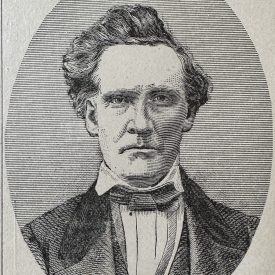
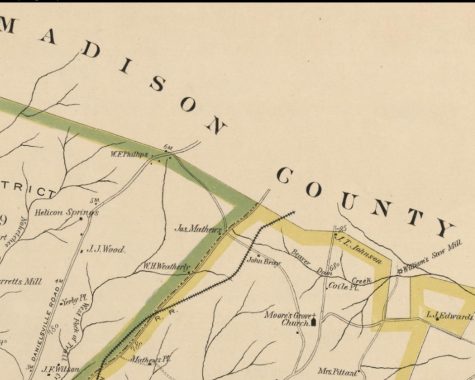
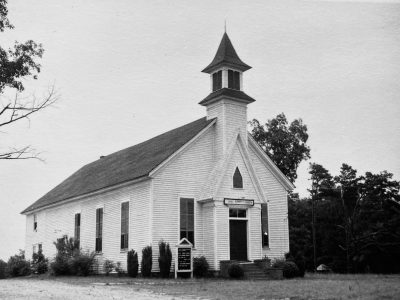
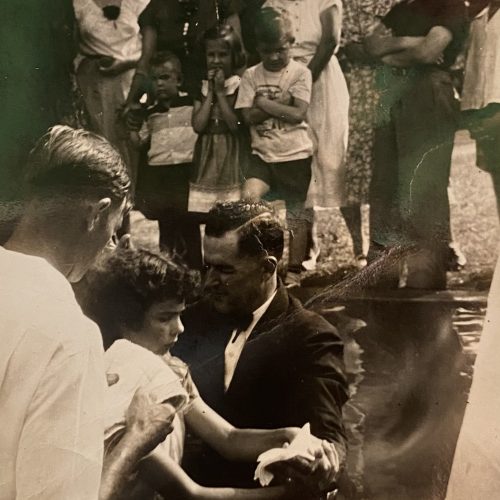
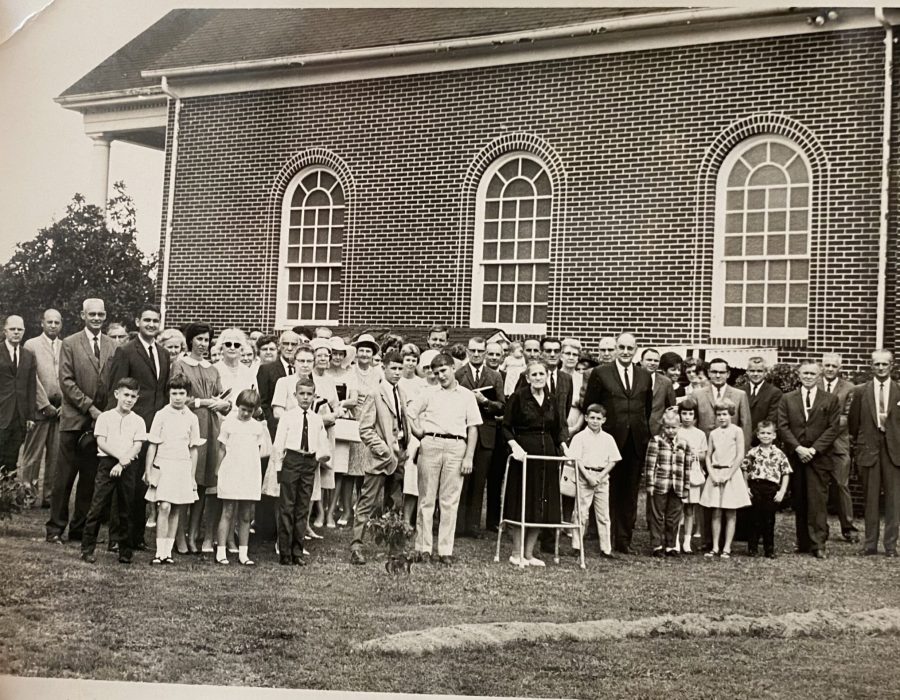
Historical Overview of Hull Baptist Church
19th Century ~ The Early Years
The probability exist that the church began as a preaching station supplied by the Sarepta Baptist Association before coming a church. The church was established in 1853 in Clarke County near the Madison County line. It was first named Sulphur Springs Baptist Church. The church meeting house was located near Sulphur Springs Creek not far from the current location. The founding pastor was Peter Patrick Butler who was the chairman of the “presbytery” of ministers who formally organized the church.
Shortly after its founding, the church was offered three acres of property less than a mile away on the Athens Road. It was donated by Dr. R. D. Moore of Athens, in honor of his gift, the church was renamed “The Moore’s Grove Baptist Church of Christ.” It was common during this era for new Baptist churches to include the “of Christ” as a part of their name. The denomination known as the Church of Christ argued they were the true “Church of Christ” because it was in their name. Not to be outdone many Baptist churches often added “of Christ” to their names.
The first report to the association in 1853 reported a membership of 13. It should be noted that it was rare for anyone under 12 to be accepted into membership until the 1940s. With large farm families of the day, attendance would have probably been much higher. Furthermore, the church only met for worship one weekend a month on the 1st weekend. Typically, people from other churches visited on the weekends their church did not have preaching scheduled that day.
The church typically met on Saturday afternoon for service after which the church had a monthly conference and again on Sunday morning. This schedule allowed the pastors, who often did not live nearby, to travel to and from their homes. Except for the August revival season, members were typically received during the conference on Saturday. The conference was where church attendance was monitored, unexcused absences from worship could result in excommunication from the church. Other charges of unruly conduct by members were also taken up including dancing, drunkenness, cursing, adultery, and any other unseemly behavior.
Early church membership included African Americans who were enslaved. Following the Civil War, newly liberated church members of southern churches began establishing their own congregations. In 1882 Moore’s Grove minutes record the organization of the New Grove Baptist Church, whose building is located on the Old Elberton Road in Winterville. For a period, New Grove used Moore’s Grove meeting house until they could construct their own. A listing of “collard members of Moors Grove Church” updated in the early 1870s is on page 13 of minutes of that era, and includes 21 names. A revised list on page 14 as of October 1877 lists 15 names.
In 1875 the church organized a Sunday School. This meant that there was a weekly ministry at the church for part of the year. Early Sunday School was for children, in time it would expand to all ages.
In 1896 the church decided to relocate to the new railroad village of Hull, created as a stop on the Seaboard Airline Railroad which was built in 1891-1892. Hull had a small depot and was a water stop. The Madison County newspaper noted the church was moving because there were more “sinners in the new town to convert.” The move to the new location was only a mile from the old one, but it placed the church in proximity to the village and within walking distance of more people and within Madison County. The Bullock family gave a one-acre lot on which to build.
The economy was agriculturally based in this section of Clarke, Madison, and Oglethorpe counties during this era.
Early 20th Century
The early 20th century saw the church and village of Hull continue to grow. A post office, cotton gin, several businesses, a railroad, and businesses provided employment. Spratlin Mill and others like it added to the local community. The Methodist also had a church in Hull, located on the lot south of Moors Gove Baptist. When it closed its doors, Madison County acquired the lot and built the Hull School. The school operated until 1939, the property reverted to the Bullock family and was given to Moors Gove Baptist.
The automobile began having an impact on the community in the early twentieth century. By the year 1950, pastors were no longer arriving by horse, buggy, or train, they were driving as were other members of the church. This contributed to expanding ministries as people had more mobility. In 1942, under the leadership of pastor Logan, the church not only built a Sunday School addition but worship increased from two Sundays a month to becoming a “half-time church.”
In 1946 the church, reflecting its location was renamed “Hull Baptist Church” with the blessing of the descendants of Dr. Moore. The church moved through the difficult years of the depression, WW2 under the steady leadership of pastor A.E. Logan, who was also a teacher for many years at the Hull School.
Late 20th Century
Following WW2, the community continued to evolve. Farming still was the primary business, but increasingly Hull was becoming a bedroom community of Athens. The University of Georgia being a large employer was seven miles from Hull. Other industries began to develop in the surrounding areas which produced jobs. The enrollment of UGA increased from around 5,000 in 1950 to approximately 30,000 by the year 2000.
As the Baby Boom and their children helped fuel growth in the community and church. Reflecting that growth and change the church, in 1951, went to “full-time” status with worship services each Sunday. The church continued to add facilities throughout the rest of the century as noted below.
By the end of the 20th century, farming was no longer the primary source of income for the Hull community.
21st Century
By the year 2000, the total church membership had grown to 670.
The church continued to move forward and much of this can be attributed to the long-term pastorate of Rev. Randy Crow who was called in 1993 and retired in 2019 after 27 years of service. The church continued to redefine and refocus through Covid 19 and its aftermath, with a commitment to the future to focus on evangelism and discipleship, with a call to the church and community to “Come-Seek-Be Filled.”
Rev. Jeff Tinsley began his ministry and leadership of Hull Baptist on the first Sunday of June 2023.
Signs of Progress: Meeting Houses and Other Structures
- 1853 according to oral tradition the first Meeting House was a log structure that was also used as a schoolhouse.
- 1853 a Meeting House was constructed on 3 acres of land donated by Dr. Moore on the old Athens Road near Adoms Spring.
- 1857 Requested permission to build a pool on Dr. Moors land near the spring
- 1880’s a baptismal changing shed near the outdoor pool on Sulphur Springs Creek.
- 1896 church relocates to the new town railroad town of Hull, sanctuary constructed on current location.
- 1942 addition of educational space.
- 1954 additional educational space and new brick veneer added.
- 1961 pastorium built at Highway 72 and Spratlin Mill Road.
- 1968 additional education space completed.
- 1968 the “Brown House” was donated to the church and used to house the Minister of Music.
- 1988 the “Wilson House” was donated and put to use as educational space.
- 1993 Family Life Center (gymnasium, social hall, kitchen, and office space) completed.
- 1996 Sanctuary renovated; seating capacity enlarged.
Pastoral Leadership
As of this writing (2023), there have been 27 pastors who have served Hull Baptist. Until 1961 they were bi-vocational. Most have been farmers, educators, millers, a machinist, and at least one lawyer.
Because the church had services only once a month, most of these men served several churches. At least two of them lived as far away as Atlanta and one lived in Hall County, these men would have most likely commuted by train. A family would house them for the weekend and others would take turns feeding the preacher. Several pastors lived in the immediate vicinity of the church, this included J.N. Coile (farmer), J.P. Cooper (machinist), and A.E. Logan (educator). And Marshall W Edwards (farmer).
Until the early 20th century, the church extended an annual call. This was on a contractual basis, meaning the pastor could not leave without the formal consent of the church. Each year the pastor could inform the church he would not return, or the church could on rare occasions not extend a call.
Many of the ministers were not paid a set salary, although some according to the records were. Typically, they were paid in the fall after the crops had been sold at market. In May of 1860, a motion was made that beginning of every year the clerk prepare a subscription at the beginning for the purpose of paying the pastor.” W.R. Goss stated to the church in the 1880s that he would consider returning provided the church paid him what was past due. The first fixed-salaried, full-time pastor was Maurice Fain in 1961.
There were two cases of father-son ministries J.N. Coile and W.M. Coile, and Sam Wingfield and Joe Wingfield. The Goss brothers Isham and William Rayun were another family duo. Isham Goss is the only pastor to have died while he was serving the church. His income was supplemented by the building of a parsonage in 1961.
The longest-tenured pastors were A.E. Logan (37 years) and Randy Crowe (27).
Pastors Hull Baptist
1853-1854 Peter Patrick Butler
1855 Bedford Langford
1856-1857 Asa Duncan
1858-1859 David Hensley Payne
1860-1865 James Power Rowe
1866 Marshall W. Edwards
1867-1873 James N. Coile
1874-1879 Isham H. Goss
1880-1883 William Rabun Goss
1884-1891 Rev. William Marion Coile
1891-1896 Rev. M. S. Weaver
1896 Rev. Hugh L. Brock
1897-1898 Rev. Benjamin Franklin Elliot
1899 Rev. M. S. Weaver
1901-1909 Rev. W. M. Coile
1911-1912 Rev. James Pinkston Cooper
1913 Rev. Gill
1914 Rev. Pruett
1915-1919 Rev. Alfred E. Logan
1919 Rev. Manasseh Joseph O’Kelly
1920 Rev. A. E. Logan
1921-1922 Rev. James Solomon Settle
1923 Rev. W.M. Coile
1924 -1925 Rev. J.P. Cooper
1926-1927 Rev. James Madison Lawson
1928 Rev. Sam B. Wingfield
1929-1961 Rev. A. E. Logan
1961-1963 Rev. John Maurice| Fain
1963-1972 Rev. Joe A. Wingfield
1972-1986 Rev. Bobby Jones
1986-1992 Rev. Roy Crowe
1993-2019 Rev. Randy Crowe
2023 Rev. Jeff Tinsley
History compiled by Pastor Charles Jones c. 2023
